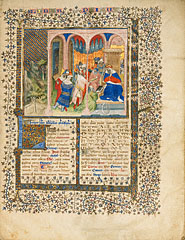• What do you see happening in the illuminated
scene on this page?
• Who do you think the seated man in blue and red might be? What clues can you find as to his identity?
• The object in front of the King is an astrolabe. Who do you think might use an astrolabe? (Astronomers. Sailors also use a mariners' astrolabe.)
• What words can you identify in the text area of the page? (Some easily indentifiable words on this page are the planets Venus and Saturn and signs of the zodiac such as Taurus, Gemini, Cancer, and Libra.)
• The science of astrology, along with the reading of minds, is one of the subjects covered in this book. How do we view astrology today? In what ways does it relate to science?
• This richly illuminated page is made in what is called the International Style. As a class, list some words that you think characterize this style from the elements you see on this page.
See more pages from this book. |
The opening page of the Book of the Philosopher Alchandreus depicts the author, Alchandreus, kneeling and presenting his text to a king, probably Alexander the Great, who is cited in the text. Alchandreus was famous for his writings on the movement of the planets and the distances between the stars. He was greatly influenced by Arabic writings on astrology and was given the title of Supreme Astrologer. He is shown with the instrument of the astronomer's work, the astrolabe, and he and the king are surrounded by a group of exotically dressed scholars who appear to be engaged in a lively debate. At this time astrology (predicting the future by means of the observation of the stars) was not distinguished from natural astronomy (the observation of the stars).
The Book of the Philosopher Alchandreus consists of texts that cover diverse themes such as the nature, movement, and influence of the planets, the signs of the zodiac, the 28 houses of the moon, and the reading of minds. The Book of the Philosopher Alchandreus is accompanied by two texts by the Roman scholar Boethius: De arithmetica (Concerning Arithmetic) and De musica (Concerning Music). The manuscript also originally included a treatise on the abacus, De regule abaci (Concerning the Rules of the Abacus), by an English scholar, Adelardus of Bath. The abacus, like the astrolabe, has its roots in the ancient Arabic world. Most of these texts are based on Arabic writings and attest to the influence of Near Eastern scientific thought on medieval European scholars.
About the Artist
Medieval artists often did not sign their works, so modern scholars give them names of convenience. The Virgil Master was named after a famous illuminated manuscript containing Virgil's Bucolics and Aeneid. The Virgil Master worked at the court of the important art patron Jean, duc de Berry from 1390 to the 1410s. Jean de Berry owned at least six manuscripts illuminated by the Virgil Master. De Berry's treasurer, Jacques Courau, also commissioned several books by the artist. The Virgil Master also collaborated with other leading illuminators of the time, including the workshops of the Boucicaut Master and the Egerton Master. The Virgil Master painted highly developed narratives and often incorporated contemporary medieval details of architecture and dress into his compositions.
|
